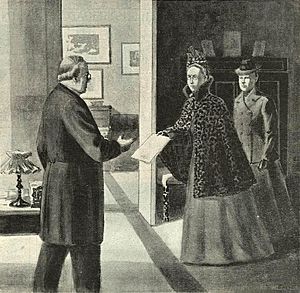Fredrika Bremer Association facts for kids

The Fredrika Bremer Association (in Swedish, Fredrika Bremer Förbundet or FBF) is the oldest group fighting for women's rights in Sweden. The association believes in equality for all people. It supports the rights of women and the LGBT community.
The FBF is known as a key part of the liberal women's movement in Sweden. It has always allowed both women and men to be members. The group is part of the International Alliance of Women and works with similar groups in Denmark, Norway, and Iceland.
Contents
What Does the Association Do?
The Fredrika Bremer Association works to make sure people support gender equality. They do this by sharing information and organizing activities. They also give out money from special funds and scholarships to help people.
The FBF works with other groups in Sweden and around the world that have similar goals. The association is a member of the International Alliance of Women. This gives them a voice at the United Nations, where they can speak about issues important to women.
The History of the Association
The Fredrika Bremer Association has a long and important history of fighting for equality in Sweden.
Getting Started in the 1880s
The group was started in 1884. The founders included the feminist Sophie Adlersparre, Ellen Anckarsvärd, Fredrika Limnell, and Ellen Fries. They named the association after the famous Swedish writer Fredrika Bremer. Her novel Hertha helped change the law so that unmarried women could be independent and control their own money, instead of being controlled by male relatives.
The main goal of the FBF was to teach women about their rights and encourage them to use them. For example, they told women they could serve on the boards of public organizations. They also reminded women who owned property that they had the right to vote in local elections.
Helping Women in the 1890s
By 1890, the FBF's office in Stockholm was a busy place. It acted as a job center for middle-class women. It also gave women free legal, financial, and medical advice. Many women also came to the office to learn about the movement to get women the right to vote, known as women's suffrage.
In 1899, the FBF officially asked the government for women's right to vote. A group led by Agda Montelius and Gertrud Adelborg gave a formal request to the prime minister. This was the first time a women's group in Sweden had made such a demand.
Growing in the 20th Century
Over the years, other groups joined the FBF. In 1890, a group that wanted to reform clothing for women became part of the association. In 1896, a group fighting for married women's right to own property also merged with the FBF.
In 1937, the association started a special committee. Its goal was to get more women involved in politics and elected to the Swedish parliament.
List of Presidents
- 1884–1903: Hans Hildebrand
- 1903–1920: Agda Montelius
- 1920–1937: Lizinka Dyrssen
- 1937–1949: Hanna Rydh
- 1949–1958: Elsa Ewerlöf
- 1958–1959: Elin Lauritzen
- 1959–1961: Inger Leijonhufvud
- 1961–1967: Anna-Greta Hybbinette
- 1967–1970: Astrid Schönberg
- 1970–1976: Karin Ahrland
- 1976–1982: Birgitta Wistrand
- 1982–1985: Monica Påhlsson
- 1985–1989: Gerd Forssell
- 1989–1990: Ann Egefalk
- 1990–1991: Eivor Lilja
- 1991–1997: Inge Garstedt
- 1997–2000: Anna-Karin Sjöstrand
- 2000–2004: Irene Rundberg
- 2004–2008: Ann Falkinger
- 2008–2013: Birgitta Wistrand
- 2013–2018: Louise Lindfors
- 2018–2019: Ulrika Kärnborg (Christina Knight, acting)
- 2020–: Camilla Wagner
See also
 In Spanish: Asociación Fredrika Bremer para niños
In Spanish: Asociación Fredrika Bremer para niños

